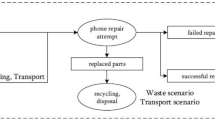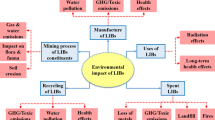Abstract
Purpose
Waste management for end-of-life (EoL) smartphones is a growing problem due to their high turnover rate and concentration of toxic chemicals. The versatility of modern smartphones presents an interesting alternative waste management strategy: repurposing. This paper investigates the environmental impact of smartphone repurposing as compared to traditional refurbishing using Life Cycle Assessment (LCA).
Methods
A case study of repurposing was conducted by creating a smartphone “app” that replicates the functionality of an in-car parking meter. The environmental impacts of this prototype were quantified using waste management LCA methodology. Studied systems included three waste management options: traditional refurbishment, repurposing using battery power, and repurposing using a portable solar charger. The functional unit was defined as the EoL management of a used smartphone. Consequential system expansion was employed to account for secondary functions provided; avoided impacts from displaced primary products were included. Impacts were calculated in five impact categories. Break-even displacement rates were calculated and sensitivity to standby power consumption were assessed.
Results and discussion
LCA results showed that refurbishing creates the highest environmental impacts of the three reuse routes in every impact category except ODP. High break-even displacement rates suggest that this finding is robust within a reasonable range of primary cell phone displacement. The repurposed smartphone in-car parking meter had lower impacts than the primary production parking meter. Impacts for battery-powered devices were dominated by use-phase charging electricity, whereas solar-power impacts were concentrated in manufacturing. Repurposed phones using battery power had lower impacts than those using solar power, however, standby power sensitivity analysis revealed that solar power is preferred if the battery charger is left plugged-in more than 20 % of the use period.
Conclusions
Our analysis concludes that repurposing represents an environmentally preferable EoL option to refurbishing for used smartphones. The results suggest two generalizable findings. First, primary product displacement is a major factor affecting whether any EoL strategy is environmentally beneficial. The benefit depends not only on what is displaced, but also on how much displacement occurs; in general, repurposing allows freedom to target reuse opportunities with high “displacement potential.” Second, the notion that solar power is preferable to batteries is not always correct; here, the rank-order is sensitive to assumptions about user behavior.



Similar content being viewed by others
Notes
Because the relationship is linear, the interested reader can use the total primary phone impacts shown in the penultimate row of Table 2 with any displacement rate to calculate net impact.
References
ABI Research (2009) “Green Mobile Devices.” http://www.abiresearch.com/research/1004179
Apple (2013) “iPhone 4s Environmental Report.” http://images.apple.com/environment/reports/docs/iPhone4s_product_environmental_report_sept2013.pdf
Canalys (2012) “Smart Phones Overtake Client PCs in 2011.” Canalys.com. http://www.canalys.com/newsroom/smart-phones-overtake-client-pcs-2011
Cherubini F, Bargigli F, Ulgiati S (2009) Life cycle assessment (LCA) of waste management strategies: landfilling, sorting plant and incineration. Energy 34(12):2116–2123
Choi SS, Lim HS (2002) Factors that affect cycle-life and possible degradation mechanisms of a Li-ion cell based on LiCoO 2. J Power Sources 111:130–136
Clift R, Doig A, Finnveden G (2000) The application of life cycle assessment to integrated solid waste management: Part 1—Methodology. Process Saf Environ Prot 78(49):279–287
Ecoinvent Centre (2012) Ecoinvent Database V2.2”. Ecoinvent Centre, Dubendorf
Ekvall T (2000) A market-based approach to allocation at open-loop recycling. Resour Conserv Recycl 29(1–2):91–109
Entner R (2011) International comparisons: the handset replacement cycle
Ericsson (2011) Traffic and market data report: on the pulse of the networked society
European Union (2008) Directive 2005/32/EC of the European Parliament and of the Council with Regard to Ecodesign Requirements for Standby and Off Mode Electric Power Consumption of Electrical and Electronic Household and Office Equipment
Falaki H, Mahajan R, Kandula S, Lymberopoulos D, Govindan R, Estrin D (2010) Diversity in smartphone usage. Proceedings of the 8th International Conference on Mobile Systems, Applications, and Services - MobiSys ’10: 179. doi:10.1145/1814433.1814453. http://portal.acm.org/citation.cfm?doid=1814433.1814453
Finnveden G (1999) Methodological aspects of life cycle assessment of integrated solid waste management systems. Resour Conserv Recycl 26:173–187
Fisher K, Wallen E, Paul Laenen P, Collins M (2006) Battery waste management life cycle assessment
Geyer R, Doctori Blass V (2009) The economics of cell phone reuse and recycling. Int J Adv Manuf Technol 47(5–8):515–525
Google (2012) Our Mobile Planet. August. http://www.thinkwithgoogle.com/mobileplanet/en/
Guinée JB, Gorree M, Heijungs R, Huppes G, Kleijn R, de Koning A, van Oers L et al (2002) Handbook on Life Cycle Assessment. Operational Guide to the ISO Standards. Kluwer, Dordrecht
HML (2004) E-waste Report: determination of regulated elements in seven types of discarded consumer electronic products. Hazardous Material Laboratory (HML), Cal EPA, Sacramento
Huisman J (2004) QWERTY AND Eco-efficiency analysis on cellular phone treatment in Sweden, TU Delft, The Netherlands, commissioned by El-Kretsen, Stockholm, Sweden
IDC (2012) IDC worldwide quarterly mobile phone tracker
Lebot B, Meier A, Anglade A (2000) Global implications of standby power use. In: The Proceedings of ACEEE Summer Study on Energy Efficiency in Buildings. Asilomar, CA
Lincoln JD, Ogunseitan OA, Shapiro AA, Saphores J-D M (2007) Leaching assessments of hazardous materials in cellular phones. Environ Sci Technol 41(7):2572–2578
Lindholm ME (2003) Toward Environmentally Conscious Product Design 1—a Comprehensive DfE Implementation in New Generation Cellular Phones, Proceeding of the ISEE 2003, 19-22 May 2003, Boston, MA
MPPI (2006) Guideline on material recovery and recycling of end-of-life mobile phones. Geneva, Switzerland
Nokia (2012) Nokia Lumia 820 Eco Profile.” http://nds1.nokia.com/eco_declaration/files/eco_declaration_phones/Lumia_820_Eco_profile.pdf
Notter DA, Gauch M, Widmer R, Wäger P, Stamp A, Zah R, Althaus H-J (2010) Contribution of Li-ion batteries to the environmental impact of electric vehicles. Environ Sci Technol 44(17):6550–6556
Oiva L, Oppermann W, Middendorf A, Zuber K-H, Stobbe I (2000) Case study on the environmental impacts of a mobile phone, Proceedings of EGG 2000, 11-13 September 2000, Berlin, Germany
Osibanjo O, Nnorom IC (2008) Material flows of mobile phones and accessories in Nigeria: environmental implications and sound end-of-life management options. Environ Impact Assess 28(2–3):198–213
PE International (2010) GaBi Electronics Database. Leinfelden-Echterdingen, Germany
PE International (2012) GaBi Professional Database. Leinfelden-Echterdingen, Germany
Rydh CJ, Sandén BA (2005) Energy analysis of batteries in photovoltaic systems. Part I: performance and energy requirements. Energy Convers Manag 46(11–12):1957–1979
Santavaara I, Paronen N (2013) Nokia’s product life cycle assessment over the years, including challenges and key findings.” In The 6th International Conference on Life Cycle Management, 4–7. Gothenburg
Schmidt JH, Holm P, Merrild A, Christensen P (2007) Life cycle assessment of the waste hierarchy—a Danish case study on waste paper. Waste Manag 27(11):1519–1530
Silveira GTR, Chang SY (2010) Cell phone recycling experiences in the United States and potential recycling options in Brazil. Waste Manag 30(11):2278–2291
Singhal P (2005) Integrated product policy pilot project—stage I Final Report: Life Cycle Environmental Issues of Mobile Phones. Espoo, Finland
Skerlos SJ, Morrow WR, Chan KY, Zhao F, Hula A, Seliger G, Basdere B, Prasitnarit A (2003) Economic and Environmental Characteristics of Global Cellular Telephone Remanufacturing. In: IEEE International Symposium on Electronics and the Environment, 2003, 99–104. IEEE. http://ieeexplore.ieee.org/xpls/abs_all.jsp?arnumber=1208055
Thomas VM (2003) Demand and dematerialization impacts of second-hand markets: reuse or more use? J Ind Ecol 7(2):65–78
U.S. Congress (2007) Energy Independence and Security Act of 2007
Weidema B (2000) Avoiding co-product allocation in life-cycle assessment. J Ind Ecol 4(3):11–33
Acknowledgments
We would like to thank Péter Boda from the Nokia Research Center in Palo Alto, CA for their support of this work. Additionally, we would like to thank Linda Gaines at Argonne National Laboratories for her insights on battery production, and Lee Hefernan at PowerTraveller for providing detailed logistics information.
Author information
Authors and Affiliations
Corresponding author
Additional information
Responsible editor: Stig Irving Olsen
Electronic supplementary material
Below is the link to the electronic supplementary material.
ESM 1
(PDF 798 kb)
Rights and permissions
About this article
Cite this article
Zink, T., Maker, F., Geyer, R. et al. Comparative life cycle assessment of smartphone reuse: repurposing vs. refurbishment. Int J Life Cycle Assess 19, 1099–1109 (2014). https://doi.org/10.1007/s11367-014-0720-7
Received:
Accepted:
Published:
Issue Date:
DOI: https://doi.org/10.1007/s11367-014-0720-7




